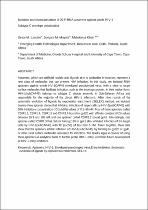 ResearchSpace
ResearchSpace
Isolation and characterization of 20'-F-RNA aptamers against whole HIV-1 subtype C envelope pseudovirus
JavaScript is disabled for your browser. Some features of this site may not work without it.
- ResearchSpace
- →
- Research Publications/Outputs
- →
- Journal Articles
- →
- View Item
| dc.contributor.author |
London, GM

|
|
| dc.contributor.author |
Mayosi, BM

|
|
| dc.contributor.author |
Khati, M

|
|
| dc.date.accessioned | 2015-08-17T13:32:18Z | |
| dc.date.available | 2015-08-17T13:32:18Z | |
| dc.date.issued | 2015-01 | |
| dc.identifier.citation | London, G.M., Mayosi, B.M., and Khati, M.2015. Isolation and characterization of 20'-F-RNA aptamers against whole HIV-1 subtype C envelope pseudovirus. Biochemical and Biophysical Research Communications, Vol. 456(1), pp 1-6 | en_US |
| dc.identifier.issn | 0006-291X | |
| dc.identifier.uri | http://hdl.handle.net/10204/8022 | |
| dc.description | Copyright: 2015 Elsevier. Due to copyright restrictions, the attached PDF file only contains the abstract of the full text item. For access to the full text item, please consult the publisher's website | en_US |
| dc.description.abstract | Aptamers, which are artificial nucleic acid ligands akin to antibodies in function, represent a new class of molecules that can prevent HIV infection. In this study, we isolated RNA aptamers against whole HV-1CAP45 enveloped pseudotyped virus, with a view to target surface molecules that facilitate infection, such as the envelope protein, in their native form. HIV-1(subCAP45) belongs to subtype C viruses endemic in Sub-Saharan Africa and responsible for the majority of the global HIV-1 infections. After nine rounds of the systematic evolution of ligands by exponential enrichment (SELEX) method, we isolated twenty-three aptamer clones that inhibited infection of target cells by HIV-1(subCAP45) with 50% inhibitory concentration (IC(sub50)) values of 0.1–50 nM. Four of these aptamers called CSIR1.1, CSIR1.4, CSIR1.5 and CSIR1.6 bound to gp120 with affinity constant (KD) values between 16.9 and 195 nM and one aptamer called CSIR1.2 bound gp41. Interestingly, one aptamer called CSIR1.3 that did not bind gp120 or gp41 also inhibited infection of the target cells by HIV-1(subCAP45) with IC(sub50) of less than 5 nM. Taken together, these data show that the aptamers inhibit infection of HIV-1(subCAP45) by binding to gp120 or gp41, or other viral surface molecules necessary for infection. The results argue in favour of using these aptamers as analytical tools to further probe HIV-1 entry, and their future development as HIV-1 entry inhibitors. | en_US |
| dc.language.iso | en | en_US |
| dc.publisher | Elsevier | en_US |
| dc.relation.ispartofseries | Workflow;14687 | |
| dc.subject | Aptamers | en_US |
| dc.subject | HIV-1 | en_US |
| dc.subject | Enveloped pseudotyped virus | en_US |
| dc.subject | Entry inhibition | en_US |
| dc.subject | Systematic evolution of ligands by exponential enrichment | en_US |
| dc.subject | SELEX | en_US |
| dc.title | Isolation and characterization of 20'-F-RNA aptamers against whole HIV-1 subtype C envelope pseudovirus | en_US |
| dc.type | Article | en_US |
| dc.identifier.apacitation | London, G., Mayosi, B., & Khati, M. (2015). Isolation and characterization of 20'-F-RNA aptamers against whole HIV-1 subtype C envelope pseudovirus. http://hdl.handle.net/10204/8022 | en_ZA |
| dc.identifier.chicagocitation | London, GM, BM Mayosi, and M Khati "Isolation and characterization of 20'-F-RNA aptamers against whole HIV-1 subtype C envelope pseudovirus." (2015) http://hdl.handle.net/10204/8022 | en_ZA |
| dc.identifier.vancouvercitation | London G, Mayosi B, Khati M. Isolation and characterization of 20'-F-RNA aptamers against whole HIV-1 subtype C envelope pseudovirus. 2015; http://hdl.handle.net/10204/8022. | en_ZA |
| dc.identifier.ris | TY - Article AU - London, GM AU - Mayosi, BM AU - Khati, M AB - Aptamers, which are artificial nucleic acid ligands akin to antibodies in function, represent a new class of molecules that can prevent HIV infection. In this study, we isolated RNA aptamers against whole HV-1CAP45 enveloped pseudotyped virus, with a view to target surface molecules that facilitate infection, such as the envelope protein, in their native form. HIV-1(subCAP45) belongs to subtype C viruses endemic in Sub-Saharan Africa and responsible for the majority of the global HIV-1 infections. After nine rounds of the systematic evolution of ligands by exponential enrichment (SELEX) method, we isolated twenty-three aptamer clones that inhibited infection of target cells by HIV-1(subCAP45) with 50% inhibitory concentration (IC(sub50)) values of 0.1–50 nM. Four of these aptamers called CSIR1.1, CSIR1.4, CSIR1.5 and CSIR1.6 bound to gp120 with affinity constant (KD) values between 16.9 and 195 nM and one aptamer called CSIR1.2 bound gp41. Interestingly, one aptamer called CSIR1.3 that did not bind gp120 or gp41 also inhibited infection of the target cells by HIV-1(subCAP45) with IC(sub50) of less than 5 nM. Taken together, these data show that the aptamers inhibit infection of HIV-1(subCAP45) by binding to gp120 or gp41, or other viral surface molecules necessary for infection. The results argue in favour of using these aptamers as analytical tools to further probe HIV-1 entry, and their future development as HIV-1 entry inhibitors. DA - 2015-01 DB - ResearchSpace DP - CSIR KW - Aptamers KW - HIV-1 KW - Enveloped pseudotyped virus KW - Entry inhibition KW - Systematic evolution of ligands by exponential enrichment KW - SELEX LK - https://researchspace.csir.co.za PY - 2015 SM - 0006-291X T1 - Isolation and characterization of 20'-F-RNA aptamers against whole HIV-1 subtype C envelope pseudovirus TI - Isolation and characterization of 20'-F-RNA aptamers against whole HIV-1 subtype C envelope pseudovirus UR - http://hdl.handle.net/10204/8022 ER - | en_ZA |





